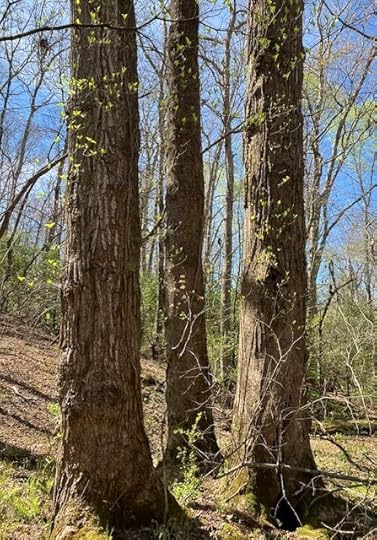The Three Sisters

I don’t know who gave the name “The Three Sisters” to the three tulip trees standing together, tall and straight, around a small natural spring. It was probably my mother. She was so good at naming things and places.
Whoever named them, they were a central part of one of my favorite places as my siblings and I grew up. We four youngest of Mamma’s and Daddy’s ten were the main ones I remember playing there but older ones did come sometimes, especially for picnics.
Indian Spring, a few feet south of the Three Sisters, and its little companion spring we called Indian Children’s Spring had been dug by the natives sometime a hundred years or more before us. Flagstones lined the bottom of the fifteen foot circular dugout, although silt buildup kept them covered much of the time. On the upper side a constant clear trickle issued from deep in the hillside, stirring the pool with tiny ripples. One person at a time could clamor down mossy stone steps for drinking the coolest, most refreshing water in the state of Georgia. We kept a cup hung over a broken limb, but water from a hastily fashioned oak leaf cup tasted even better.
Close by the banks of Indian Spring rose a steep bluff thickly wooded with oak, pine, and a nice undergrowth of hazelnut bushes, spice bush, and sweet ferns. An old Indian trail wound along a nearby brook through thick mountain laurel and wild azalea, around the springs, and then circled the steep bluff on its way to whatever the village might have been before, in 1823, Clarkesville was established. And standing like a protective trio around the Indian Children’s Spring were those tall elegant tulip poplar trees.
The trees were like friendly sentinels keeping watch over us. In springtime they watched my sister Suzanne and me make princesses and boats with the orange and green blossoms the trees dropped. In summer they watched as my brother Charlie built a waterwheel powered by one of the brook’s little waterfalls. In fall they watched as we tumbled down the steep bluff, rustling the leaves and, on rare days, gleaning a few hazelnuts the squirrels had missed. In winter they watched as we crossed the brook either balancing on a wonderful big fallen tree or jumping from stone to stone. They watched as we picnicked, played hide and seek, hunted water lizards, and built dams with brook stones. And they listened as my brother Stanley spun such vivid tales we could all but see the Indian children playing around the springs just as we did.
Now that we’re all grandparents, some even enjoying heaven, the Three Sisters still stand there by the little Indian Children’s Spring. They haven’t changed all that much; they’re just a little stouter and bear a few more storm scars. But we’ve changed a lot! They’ve watched our children play around the springs and then our children’s children too. But often now, I think, the Three Sisters hear only the bubbling of the brook and the rustle of leaves in a breeze, the hoot of an owl at night, or the scurry of squirrels at dawn.
Do they miss us very much? Probably not. After all, they are only trees.
The picture above is by Suzanne Knight Dover.
Brenda Knight Graham's Blog
- Brenda Knight Graham's profile
- 1 follower



